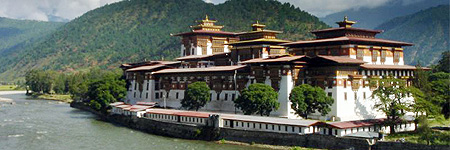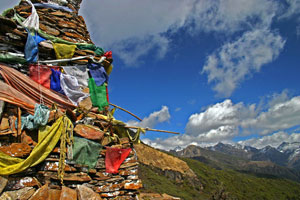|
|
Bhutan History |
|
 |
|
|
|
History of Bhutan
Bhutan has been fortunate enough to never be colonized. It has
managed to retain a purity of culture that is entirely local
with very few outside influences. Although recorded history
mentions Bhutan in the 7th century, its existence as an
independent entity was recognized even before that, when
Buddhism reached the land. The temples built during that time
still stands, revered by the Bhutanese. In the 8th century,
the great Tantrik mystic, Guru Padmasambhava or Guru Rinpoche
came to Bhutan from Swat, in present-day Pakistan, and spread
the Buddhist faith throughout Bhutan. After a long period of
internal strife, the country was united by Shabdrung Ngawang
Namgyal who consolidated his spiritual and temporal authority
over Bhutan with some frequent battles with Tibetan and
Mongolian armies in 1616. Shabdrung means at whose feet one
submits. The Shabdrung was the father and unifier of medieval
Bhutan. After repelling numerous Tibetan invasions, the
Shabdrung subdued the many warring feudal overlords and
brought all of Bhutan under the influence of the Drukpa Kagyud
School. The Shabdrung established the Drukpa Kagyupa tradition
of Mahayana Buddhism, from which Bhutan derives its native
name of Druk Yul. The sect has continued to live still without
interruption as the state religion. His 35-year reign also saw
the establishment of a nationwide administration, aspects of
which still endure, and the building of dzongs as easily
defensible fortresses and seats of local government. In fact,
many of the dzongs one sees today were built during the
Shabdrung's reign. Bhutan also remained isolated and
independent for centuries. For 300 years, following the
arrival of westerners, only 13 European expeditions passed
through Bhutan’s borders. The most recent watershed in
Bhutan's history was the coming to power of Ugyen Wangchuk,
the first hereditary monarch of Bhutan. Ugyen Wangchuk
pacified the feuding Regional Governors who had plunged Bhutan
into a state of almost perpetual civil war. Having
consolidated his authority across the entire country by 1885,
he played the key mediator role between the British and the
Chinese. Finally, on December 17, 1907, Ugyen Wangchuk was
unanimously elected by all Regional Governors and the Central
Monastic Body, at the Punakha Dzong and crowned "Druk Gyalpo"
(literally, precious ruler of the dragon people). The present
king, the fourth hereditary monarch, is Druk Gyalpo Jigme
Singye Wangchuk, upon whose coronation in 1974 Bhutan opened
its doors to tourists. The monarch has thrived ever since and
the present King Jigme Singye Wangchuck receives overwhelming
love and support of his people. |
|
|
|
Lhotshampas, people of Nepali origin, and Drukpas,
Buddhist Bhutanese of Tibetan origin are the two major
ethnic communities of Bhutan. Both are distinctly
different and differ in culture, language and religious
traditions. They had been living without little
interaction since the late 1800s when the Lhotshampas
began immigrating to south Bhutan in search of farmland
and economic prosperity where they retained their
starkly different Nepali Hindu culture. With the passing
of a legislation in 1985 that mandated Lhotshampas
should adopt |
 |
|
|
Drukpa
culture, language and religion, tensions between the two
groups grew. The use of the Nepali language and television
viewing were banned, the national dress code, which consisted
of the Drukpa bakkhoo, was enforced in public areas. A
national program verifying citizenship of Bhutan's residents
and deportation program was instituted where a large majority
of Lhotshampas was declared illegal immigrant. |
|
|
|
Protest, violence and killings ensued and
the Lhotshampas organized demonstrations asking for repeal of
the newly implemented laws. However, what followed was a
series of arrests, atrocities, escalating violence and their
forceful eviction. Between 1988 and 1994, more than a hundred
thousand Lhotshampa refugees who had lived in Bhutan for
generations fled their homes and sought refuge in refugee
camps in south-eastern Nepal. The most widely accepted reason
for the differences and conflict between the Drukpas and the
Lhotshampas is cultural friction. The Bhutanese government,
which is predominantly Drukpa, feared that their
Buddhism-based culture was gradually being swamped by the
Hindu practices and cultural traditions of the Lhotshampas. In
the early 1980's, roughly 30 percent of the Bhutanese
population comprised of Lhotshampas, with their numbers
steadily increasing. However, it is also believed that the
real reason for the conflict was that though Bhutan was a
monarchy, educated Lhotshampas had begun infiltrating
high-level positions in the government and advocating
democracy. The neighbouring state of Sikkim, which used to be
autonomous state 1973 (and is a part of India now),
Lhotshampas were believed to have gradually replaced the
aboriginal Lepcha and Bhutiya communities in the political
structure. They had then been the primary reason for Sikkim's
consolidation into India. The Drukpas feared a similar
occurrence in Bhutan, and what followed was widespread
eviction of the Lhotshampas. |
|
|
|
In
1985, all forward looking socio-economic programmes that
exposed Bhutanese to Western culture were brought to an
abrupt halt in. Opposition to the monarchy was
suppressed, contact with foreign countries was cut off,
television was banned, tourism was reduced, Lhotshampas
were identified as a threat to the Drukpa monarchy and
attempts were made to destroy their cultural and
religious identity. The Drig Lam Namsha (code of
cultural correctness) decreed all Bhutanese
(specifically Lhotshampas) to wear traditional Drukpa
clothes in public. |
 |
|
|
|
|
Use of
Dzonkha, the Drukpa dialect, was made mandatory in all public
areas despite the inability of a large number of Lhotshampas
to speak it. The practice of Hinduism or any religion other
than Mahayana Buddhism was prohibited. When the Lhotshampas
protested against these laws as violation of their human
rights and defied the Drig Lam Namsha, they were accused of
rebelling against the king, the kingdom and the government.
Violent confrontations ensued and new laws stipulated that
only those individuals who could provide proof of being a
resident of Bhutan prior to 1958 were eligible for
citizenship. The only acceptable proof of being a resident of
Bhutan prior to 1958 was registration with the Ministry of
Home Affairs. However, according to historians, the Ministry
of Home Affairs did not exist in 1958 and was established only
ten years later in 1968. Thus, the new legislation was one of
intrigue and political deceit that made it impossible for
Lhotshampas to claim Bhutanese citizenship. The conflict
reached its peak during the months of September and October in
1990 with a series of hunger strikes and public demonstrations
that resulted in violence and killings. The army was deployed
to stem the demonstrations and mass murder, rape, torture and
imprisonment followed. Tens of thousands Lothshampas were
forcibly evicted from the country, with arbitrary arrests,
beatings, rape, robberies and other forms of intimidation
being practiced by the police and army.
Bhutan has also made a treaty agreement with India under which
it accepts India's guidance in foreign relations and at the
same time, it also tries to retains its independence. It has
also been consistently cautious with respect to contact with
outside world. The flow of foreign tourists and the speed of
social and economic changes are also controlled by the Bhutan
government. The government has also made considerable efforts
to uphold traditional values and beliefs, and strongly guards
the country’s religious and cultural traditions. |
|